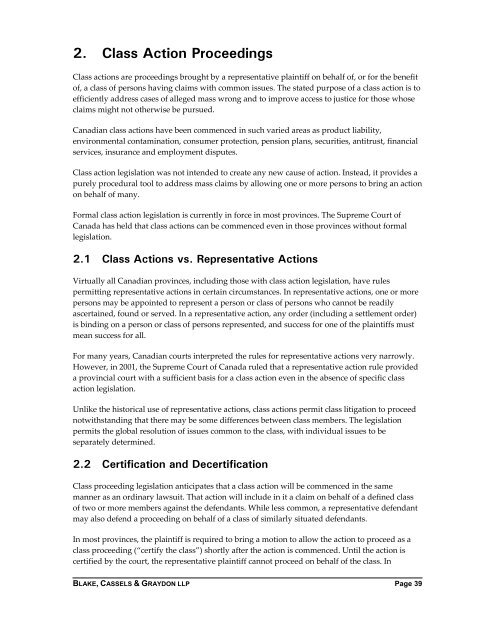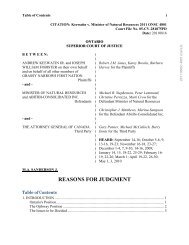Litigation and Dispute Resolution Guide
Litigation and Dispute Resolution Guide
Litigation and Dispute Resolution Guide
You also want an ePaper? Increase the reach of your titles
YUMPU automatically turns print PDFs into web optimized ePapers that Google loves.
2. Class Action ProceedingsClass actions are proceedings brought by a representative plaintiff on behalf of, or for the benefitof, a class of persons having claims with common issues. The stated purpose of a class action is toefficiently address cases of alleged mass wrong <strong>and</strong> to improve access to justice for those whoseclaims might not otherwise be pursued.Canadian class actions have been commenced in such varied areas as product liability,environmental contamination, consumer protection, pension plans, securities, antitrust, financialservices, insurance <strong>and</strong> employment disputes.Class action legislation was not intended to create any new cause of action. Instead, it provides apurely procedural tool to address mass claims by allowing one or more persons to bring an actionon behalf of many.Formal class action legislation is currently in force in most provinces. The Supreme Court ofCanada has held that class actions can be commenced even in those provinces without formallegislation.2.1 Class Actions vs. Representative ActionsVirtually all Canadian provinces, including those with class action legislation, have rulespermitting representative actions in certain circumstances. In representative actions, one or morepersons may be appointed to represent a person or class of persons who cannot be readilyascertained, found or served. In a representative action, any order (including a settlement order)is binding on a person or class of persons represented, <strong>and</strong> success for one of the plaintiffs mustmean success for all.For many years, Canadian courts interpreted the rules for representative actions very narrowly.However, in 2001, the Supreme Court of Canada ruled that a representative action rule provideda provincial court with a sufficient basis for a class action even in the absence of specific classaction legislation.Unlike the historical use of representative actions, class actions permit class litigation to proceednotwithst<strong>and</strong>ing that there may be some differences between class members. The legislationpermits the global resolution of issues common to the class, with individual issues to beseparately determined.2.2 Certification <strong>and</strong> DecertificationClass proceeding legislation anticipates that a class action will be commenced in the samemanner as an ordinary lawsuit. That action will include in it a claim on behalf of a defined classof two or more members against the defendants. While less common, a representative defendantmay also defend a proceeding on behalf of a class of similarly situated defendants.In most provinces, the plaintiff is required to bring a motion to allow the action to proceed as aclass proceeding (“certify the class”) shortly after the action is commenced. Until the action iscertified by the court, the representative plaintiff cannot proceed on behalf of the class. InBLAKE, CASSELS & GRAYDON LLP Page 39
















